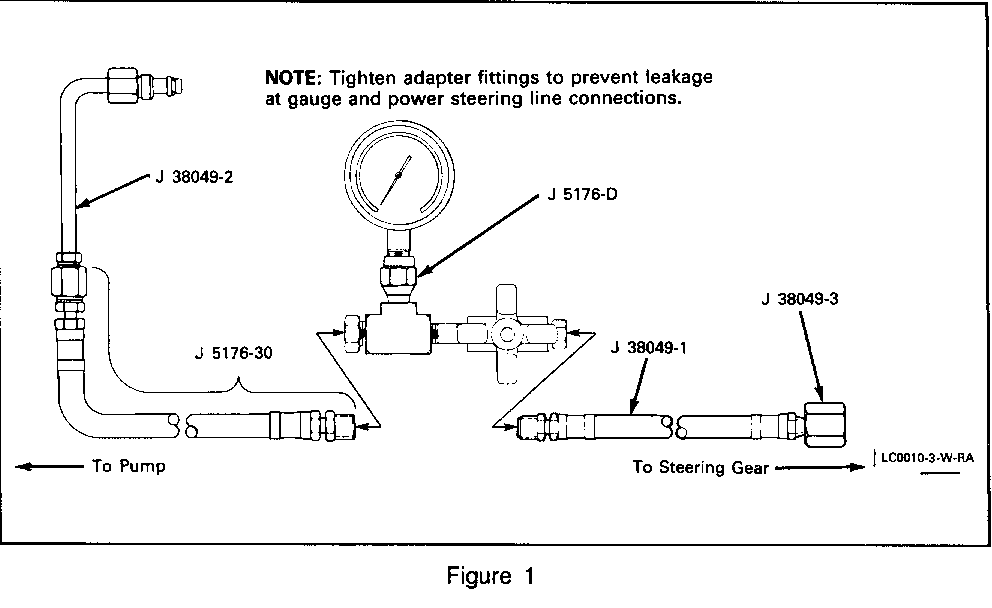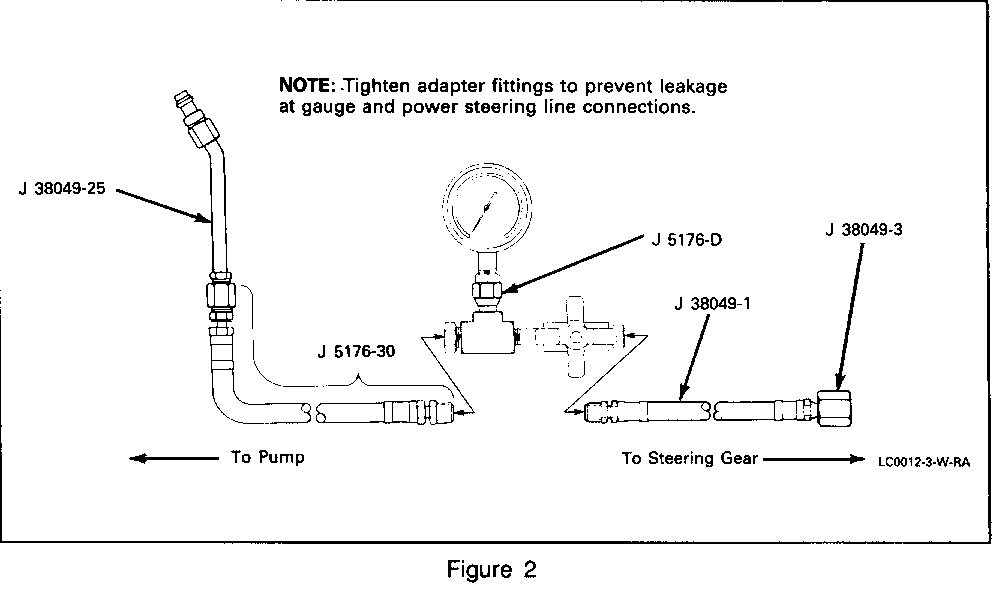MANUAL UPDATE: P/S PRESSURE CHECK PROCEDURE

Models Affected 1988-89 GRAND PRIX WITH 2.8L 3.1L ENGINES
This Power steering pressure test procedure replaces the procedure found in the following Service Manuals.
Division Model Year Pages -------- ---------- ----- Pontiac 1988 3-7 Pontiac 1989 3 -11
POWER STEERING SYSTEM TEST PROCEDURE:
2.8 - 3.1L Engine
Tools Required:
J 5176-D Power steering Pressure Tester J 5176-30 Hose Assembly J 25323-A Power Steering System Analyzer J 38049-2 Tube Assembly J 38049-3 Tube Nut
1. Remove fuse block shield.
2. Remove A.I.R. pump belt (manual transaxle only).
3. Remove serpentine belt from power steering pump pulley.
4. Remove retaining clip from high pressure pipe.
5. Remove high pressure pipe from pump.
- Place a drain pan under vehicle to catch any fluid that may drain.
6. Position high pressure pipe towards right strut.
7. Install serpentine belt.
8. Install J 5176-D as shown in Figure 1.
9. Open the valve on J 5176-D.
10. Start engine and allow system to reach operating temperature. Stop engine and check fluid level, adding fluid if required. When system is at normal operating temperature, the pressure reading on the gage (valve open) should be under 1034 kPa (150 psi). If this pressure is above 1034 kPa (150 psi) stop engine, check the hoses for restriction.
11. Start the engine and let it idle. Fully close the valve 3 times. (Do not leave the valve fully closed for more than 5 seconds, as the pump could be damaged.) Record the highest pressure attained each time the valve is closed. Each reading should show at least 8,619 kPa (1,250 psi). The three readings should be within 345 kPa (50 psi) of each other.
A. If the pressure readings are high enough (at least 8,619 kPa or 1,250 psi) and are within 345 kPa (50 psi) of each other, the pump is functioning properly.
B. If the pressure readings are high enough, but are not within 345 kPa (50 psi) of each other, the flow control valve in the pump is sticking. Remove the valve; clean it and remove any burrs using crocus cloth or fine hone. If necessary, flush the system.
Notice: Do not attempt to disassemble the flow control valve.
C. If the pressure readings are less than 8,619 kPa (1,250 psi), replace the flow control valve and recheck. If the pressures are still low, inspect the rotor and vanes and replace if necessary.
12. Shut off engine and remove J 5176-D.
13. Partially remove serpentine belt.
14. Install high pressure pipe to pump and close retaining clip to high pressure pipe.
15. Install serpentine belt to power steering pump pulley.
16. Install A.I.R. pump belt (manual transaxle only).
17. Install fuse block shield.
18. Bleed system and check fluid level.


General Motors bulletins are intended for use by professional technicians, not a "do-it-yourselfer". They are written to inform those technicians of conditions that may occur on some vehicles, or to provide information that could assist in the proper service of a vehicle. Properly trained technicians have the equipment, tools, safety instructions and know-how to do a job properly and safely. If a condition is described, do not assume that the bulletin applies to your vehicle, or that your vehicle will have that condition. See a General Motors dealer servicing your brand of General Motors vehicle for information on whether your vehicle may benefit from the information.
